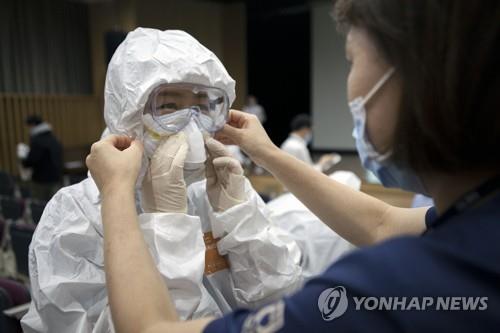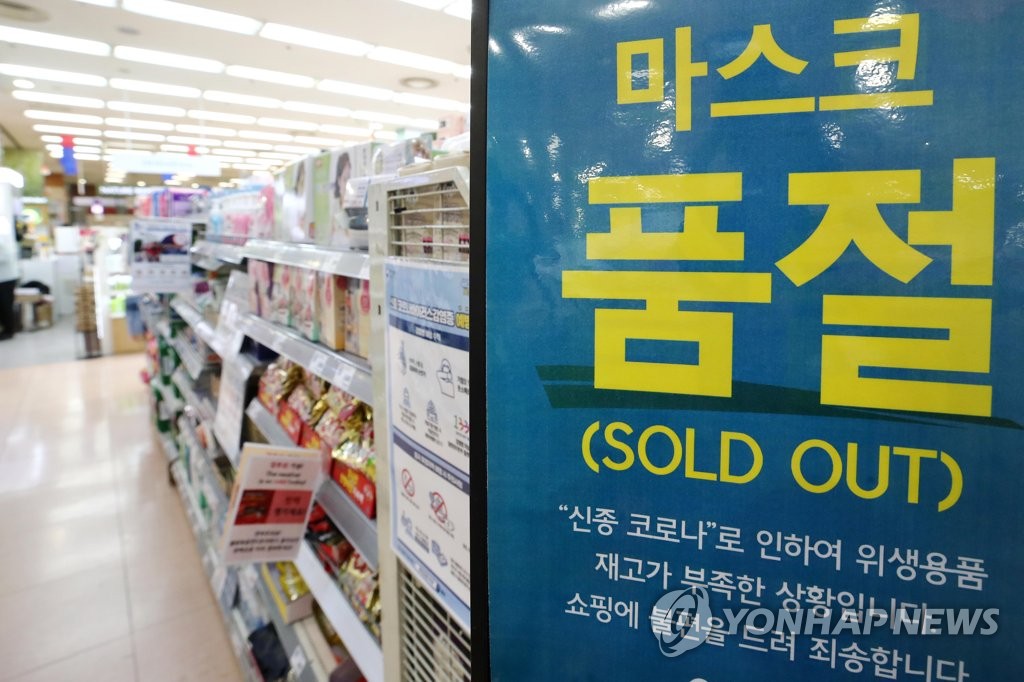- California Assembly OKs highest minimum wage in nation
- S. Korea unveils first graphic cigarette warnings
- US joins with South Korea, Japan in bid to deter North Korea
- LPGA golfer Chun In-gee finally back in action
- S. Korea won’t be top seed in final World Cup qualification round
- US men’s soccer misses 2nd straight Olympics
- US back on track in qualifying with 4-0 win over Guatemala
- High-intensity workout injuries spawn cottage industry
- CDC expands range of Zika mosquitoes into parts of Northeast
- Who knew? ‘The Walking Dead’ is helping families connect
S. Korea’s virus cases top 1,700 on surge in infected church followers
South Korea reported yet another record spike of new cases of the novel coronavirus on Thursday, with most new infections identified in the hardest-hit city of Daegu as virus tests started on more than 210,000 members of a religious sect at the center of the epidemic.
The 505 new cases, marking the sharpest daily spike yet and outnumbering the 433 new cases reported in China, where the virus originated, earlier in the day, took the nation’s total infections to 1,766, according to the Korea Centers for Disease Control and Prevention (KCDC).
A 75-year-old virus patient who is tied to the religious sect in Daegu died of respiratory failure earlier Thursday, bringing the nation’s death toll to 13.



Medical staffers at Seoul Medical Center in Seoul practice wearing protective gear on Feb. 27, 2020, ahead of the center’s upcoming change from being a general hospital to a COVID-19-only one, in this photo provided by the clinic. (Yonhap)
About 46 percent of confirmed cases here are tied to a branch of a religious sect in the southeastern city of Daegu.
Amid lingering concerns about a so-called community spread, sporadic cases in other cities and provinces have been growing. Untraceable virus cases or confirmed cases that are in the process of having their origins tracked down stood at 717.
Only 2.1 percent of total infections, or 33 cases, are tied to people who had recently traveled overseas or come in contact with them, the KCDC said.
A 28-year-old Korean national, who was evacuated from the Chinese city of Wuhan, the epicenter of the virus, on Jan. 31, has fully recovered from the virus and will be discharged from a hospital later in the day, KCDC Director-General Jeong Eun-kyeong said.
Of the 505 new cases, 422 are in Daegu, 300 kilometers southeast of Seoul, and four are in neighboring North Gyeongsang Province. The total number of infections in Daegu and North Gyeongsang stood at 1,132 and 345, respectively.
Other major provinces and cities have also reported some infections, with Seoul reporting another seven cases, the KCDC said in a statement.
In an alarming sign that the novel coronavirus is spreading more widely in South Korea, the total number of cases in the capital of Seoul and Busan, the second-largest city, rose to 56 and 61, respectively.
Critically ill people infected with the virus are treated in so-called negative pressure rooms at hospitals to prevent the virus from further spreading within hospitals.
As such facilities have been overwhelmed in Daegu, big hospitals in Seoul said they will accept virus patients who are in critical condition.
Since raising the virus alert level to “red,” the highest level, on Sunday, health authorities have focused on halting the spread of the virus in Daegu, the epicenter of the virus outbreak here, and North Gyeongsang Province.
Experts said the number of confirmed cases is expected to jump in the coming days as health authorities began testing more than 210,000 members of the Shincheonji Church of Jesus at the center of the rapid spread in other provinces.
South Korea confirmed its first new coronavirus case from a Chinese woman from Wuhan on Jan. 20, but the pace of infections had not been alarming until Feb. 18, when a 61-year-old woman who is tied to the Daegu branch of Shincheonji tested positive for the virus.
Vice Health Minister Kim Gang-lip said in a daily briefing that authorities are expected to complete virus tests on Shincheonji members in Daegu within two or three days. Tests on about 1,300 Shincheonji members who have shown symptoms have been completed, Kim said.
Kim said authorities secured a list of 245,000 followers of Shincheonji at home and abroad and another list of 65,000 trainees for the sect.
A total of 114 people, including 10 medical workers, have been diagnosed with the virus at Daenam Hospital in Cheongdo, just south of Daegu. More than half of the fatalities in the country are related to the hospital, where most patients have mental illnesses.
Kim said the government will transfer 60 patients at the hospital to another hospital in Seoul for better treatment.
Despite an alarming surge in confirmed cases in recent days, the government again said it has no plan to expand entry bans on foreign nationals from China’s other provinces.
Currently, South Korea bans foreign nationals entering the country from China’s Hubei province, where Wuhan is located.
A petition calling for President Moon to expand entry bans to China’s other provinces has garnered more than 700,000 signatures online.
In regard to ongoing efforts to come up with a treatment for COVID-19, health authorities said they have cross checked virus samples taken from patients in the country with those collected abroad and found no meaningful signs of mutation.
Experts said that there was over 99.89 percent match in the gene sequence between domestic samples and 103 overseas samples checked.
“This means there is no change in the toxicity of the virus that can complicate finding countermeasures and lead to false virus screening results,” a source said, adding that the minor changes observed were not linked to pathogenic nature of the virus that causes people to get sick or how it is transmitted from person to person. South Korea, like other countries, has allocated funds and manpower to finding a cure for the virus.
With the virus outbreak worsening, the U.S. State Department urged Americans to reconsider travel to South Korea. U.S. President Donald Trump said that it’s not the right time to put additional travel restrictions on South Korea, but Washington could do so “at a right time.”
In a joint statement on Thursday, the South Korean and U.S. militaries said they have delayed annual joint military drills on the Korean Peninsula over the virus outbreak.
Despite concerns that the Korean economy will take a harder hit from the virus, the Bank of Korea kept its key rate unchanged but expanded its special loan programs by 5 trillion won (US$4.1 billion) to 30 trillion won to boost liquidity.
The central bank also trimmed its economic outlook to 2.1 percent from the previous 2.3 percent for Asia’s fourth-largest economy citing increased uncertainties stemming from the COVID-19 outbreak.
South Korea has released 26 fully recovered novel coronavirus patients from hospitals as of Thursday afternoon, the KCDC said.
The number of people being checked for the virus and under quarantine came to 25,568, it added. The country has tested a total of 64,886 suspected cases, with 39,318 testing negative.











